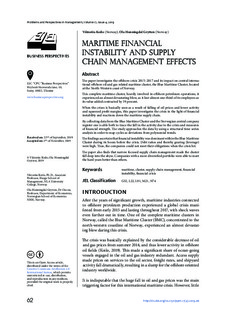Maritime Financial Instability and Supply Chain Management Effects
Journal article, Peer reviewed
Published version

View/
Date
2019Metadata
Show full item recordCollections
- Articles (SAM) [119]
- Publikasjoner fra CRIStin (NHH) [249]
Original version
10.21511/ppm.17(4).2019.06Abstract
The paper investigates the offshore crisis 2015–2017 and its impact on central international offshore oil and gas related maritime cluster, the Blue Maritime Cluster, located
at the North-Western coast of Norway.
This complete maritime cluster, heavily involved in offshore petroleum operations, it
experienced an almost devastating blow, as it lost almost one-third of its employees as
its value added contracted by 39 percent.
When the crises is basically seen as a result of falling of oil prices and lower activity
and squeezed profit margins, this paper investigates the crisis in the light of financial
instability and reactions down the maritime supply chain.
By collecting data from the Blue Maritime Cluster and the Norwegian central company
register one is able both to trace the fall in the activity due to the crisis and measures
of financial strength. The study approaches the data by using a structural time series
analysis in order to map cycles as deviations from polynomial trends.
The findings ascertain that financial instability was dominant within the Blue Maritime
Cluster during its boom before the crisis. Debt ratios and thereby gearing (leverage)
were high. Thus, the companies could not meet their obligations when the crisis hit.
The paper also finds that narrow focused supply chain management made the cluster
fall deep into the abyss. Companies with a more diversified portfolio were able to meet
the hard years better than others.
